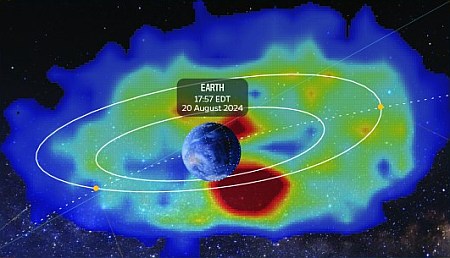Data from two different studies suggest Betelgeuse has a Sun-sized companion star

An optical image of Betelgeuse taken in 2017 by a ground-based
telescope, showing its not unusual aspherical shape.
Click for original image.
Two different independent studies have uncovered evidence that the red giant star Betalgeuse likely has an unseen companion star about the mass of the Sun and orbiting it every six years.
MacLeod and colleagues linked a six-year cycle of Betelgeuse brightening and dimming to a companion star tweaking its orbit, in a paper submitted to arXiv.org September 17. MacLeod examined global, historical measurements dating back to 1896.
Separately, Jared Goldberg of the Flatiron Institute in New York and colleagues used the last 20-odd years of measurements of Betelgeuse’s motion on the sky, which have the highest precision. That team also found evidence of a companion nudging the bigger star, submitted to arXiv.org August 17.
Previous observers noticed Betelgeuse’s light varying on a roughly six-year cycle. In 1908, English astronomer Henry Cozier Plummer suggested the cycle could be from the gravity of a companion star tugging Betelgeuse back and forth.
You can download the two papers here and here. This quote from the first paper’s abstract not only explains why the star has not been detected previously, but suggests its doomed future:
The companion star would be nearly twenty times less massive and a million times fainter than Betelgeuse, with similar effective temperature, effectively hiding it in plain sight near one of the best-studied stars in the night sky. The astrometric data favor an edge-on binary with orbital plane aligned with Betelgeuse’s measured spin axis. Tidal spin-orbit interaction drains angular momentum from the orbit and spins up Betelgeuse, explaining the spin–orbit alignment and Betelgeuse’s anomalously rapid spin. In the future, the orbit will decay until the companion is swallowed by Betelgeuse in the next 10,000 years. [emphasis mine]
The presence and future capture of this small companion star will help astronomers better calculate future fluctuations of Betelgesue itself. That capture is also going to occur relatively soon, on astronomical time scales.

An optical image of Betelgeuse taken in 2017 by a ground-based
telescope, showing its not unusual aspherical shape.
Click for original image.
Two different independent studies have uncovered evidence that the red giant star Betalgeuse likely has an unseen companion star about the mass of the Sun and orbiting it every six years.
MacLeod and colleagues linked a six-year cycle of Betelgeuse brightening and dimming to a companion star tweaking its orbit, in a paper submitted to arXiv.org September 17. MacLeod examined global, historical measurements dating back to 1896.
Separately, Jared Goldberg of the Flatiron Institute in New York and colleagues used the last 20-odd years of measurements of Betelgeuse’s motion on the sky, which have the highest precision. That team also found evidence of a companion nudging the bigger star, submitted to arXiv.org August 17.
Previous observers noticed Betelgeuse’s light varying on a roughly six-year cycle. In 1908, English astronomer Henry Cozier Plummer suggested the cycle could be from the gravity of a companion star tugging Betelgeuse back and forth.
You can download the two papers here and here. This quote from the first paper’s abstract not only explains why the star has not been detected previously, but suggests its doomed future:
The companion star would be nearly twenty times less massive and a million times fainter than Betelgeuse, with similar effective temperature, effectively hiding it in plain sight near one of the best-studied stars in the night sky. The astrometric data favor an edge-on binary with orbital plane aligned with Betelgeuse’s measured spin axis. Tidal spin-orbit interaction drains angular momentum from the orbit and spins up Betelgeuse, explaining the spin–orbit alignment and Betelgeuse’s anomalously rapid spin. In the future, the orbit will decay until the companion is swallowed by Betelgeuse in the next 10,000 years. [emphasis mine]
The presence and future capture of this small companion star will help astronomers better calculate future fluctuations of Betelgesue itself. That capture is also going to occur relatively soon, on astronomical time scales.

